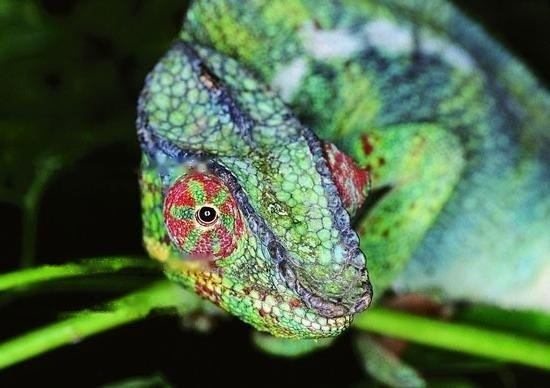The chameleon is a kind of changeable tree-dwelling reptile. In nature, it deserves to be a master of camouflage. In order to avoid the invasion of natural enemies and get close to its prey, this reptile often changes inadvertently by people. body color, and then blending itself into the surrounding environment without moving. National Geographic Magazine wrote that, according to the latest findings of animal experts, chameleons change body color not only for camouflage, but another important role of body color change is to achieve information transmission between chameleons and facilitate communication with peers. It is equivalent to human language, and then expresses the intention of the chameleon.

The length of the body is 15-25 cm (7-10 inches), and the longest is 60 cm. The body is long and cylindrical, with flattened sides, a triangular head, and a often curled tail. The eyes are bulging and can be rotated independently.
The head of some species is helmet-shaped, and some species have conspicuous headgear, such as 3 long horns that protrude forward, etc. The males are more conspicuous and may be used to defend their occupied areas. If other males invade, the dominant male will stretch his body, bulge his throat, and stand up or sway his head hair ornaments. If he still can't scare away the opponent, he will rush over and bite his palate. Various body color changes are different, and the color change mechanism is that the autonomic nervous system controls the cells (melanocytes) containing pigment granules, and diffuses or concentrates the pigment in the cells. Many species can turn green, yellow, beige or dark brown, often with light or dark spots. Color changes are determined by environmental factors such as light, temperature, and mood (scare, victory and defeat). The common belief that chameleons change color to match the color of their surroundings is actually a misunderstanding.
A chameleon is a reptile, a very strange animal with various characteristics and behaviors suitable for arboreal life. The body is about 15-25 cm long, the body is flat on the side, the back has a spine, and the occiput on the head has a blunt triangular protrusion. The limbs are very long, and the fingers and toes are combined into two opposite groups. The front three fingers of the forelimb form the inner group, the fourth and fifth fingers form the outer group; the first and second toes of the hind limbs form the inner group, and the strange three toes form the outer group. Good for holding branches. It has a long tail that can wrap around branches. It has a long, sensitive tongue that sticks out beyond its body length. People have long believed that it has glands on the tip of its tongue that secrete mucus to stick to insects, but in fact, chameleons mainly rely on the strong suction generated by the tip of their tongue to attract prey when they hunt.
Its pair of eyes is very peculiar, the eyelids are very thick and ring-shaped, the two eyeballs protrude, 180 degrees left and right, can rotate freely up and down, left and right, and the left and right eyes can move independently without coordination. This phenomenon occurs in animals. is rare. The eyes are divided into front and back, which is not only conducive to predation, but also to detect the enemy behind in time. Chameleons use their long tongues to hunt lightning fast, taking only 1/25 of a second, and their tongues are twice as long as their own bodies. The action of walking and stopping on a tree confuses predators for leaves blown by the wind.
The scientific name of the chameleon is evasion. The Chinese word for zai means something that requires effort, and evasion means that you can eat food without any effort. That's why it's called escort. Commonly known as chameleon because it is good at changing the color of its body at any time with the change of the environment. The discoloration is good for both hiding and catching prey. The physiological change of discoloration is accomplished by the expansion or contraction of pigment cells in the skin under the control of the autonomic nervous system.
![[Dog Training 5] The training method of pet dog dining etiquette](/static/img/12192/12192_1.jpg)




